
The 100s was a decade that ran from January 1, AD 100, to December 31, AD 109.
Year 104 (CIV) was a leap year starting on Monday of the Julian calendar, the 104th Year of the Anno Domini (AD) designation, the 104th year of the 1st millennium, the 4th year of the 2nd century, and the 5th year of the 100s decade. At the time, it was known as the Year of the Consulship of Suburanus and Marcellus. The denomination 104 for this year has been used since the early medieval period, when the Anno Domini calendar era became the prevalent method in Europe for naming years.

Religion in ancient Rome consisted of varying imperial and provincial religious practices, which were followed both by the people of Rome as well as those who were brought under its rule.
Julia is the nomen of various women of the family Julii Caesares, a branch of the gens Julia, one of the most ancient patrician houses at ancient Rome.

The gens Julia was one of the most prominent patrician families in ancient Rome. Members of the gens attained the highest dignities of the state in the earliest times of the Republic. The first of the family to obtain the consulship was Gaius Julius Iulus in 489 BC. The gens is perhaps best known, however, for Gaius Julius Caesar, the dictator and grand uncle of the emperor Augustus, through whom the name was passed to the so-called Julio-Claudian dynasty of the first century AD. The nomen Julius became very common in imperial times, as the descendants of persons enrolled as citizens under the early emperors began to make their mark in history.

Caesar is a title of imperial character. It derives from the cognomen of the Roman dictator Julius Caesar. The change from being a surname to a title used by the Roman emperors can be traced to AD 68, following the fall of the Julio-Claudian dynasty. When used on its own, the title denoted heirs apparent, who would later adopt the title Augustus on accession. The title remained an essential part of the style of the emperors, and became the word for "emperor" in some languages, such as German and Russian.

Alcántara is a municipality in the province of Cáceres, Extremadura, Spain, on the Tagus, near Portugal. The toponym is from the Arabic word al-Qanṭarah (القنطرة) meaning "the bridge".

Salonia Matidia was the daughter and only child of Ulpia Marciana and wealthy praetor Gaius Salonius Matidius Patruinus. Her maternal uncle was the Roman emperor Trajan. Trajan had no children and treated her like his daughter. Her father died in 78 and Matidia went with her mother to live with Trajan and his wife, Pompeia Plotina.

The Dendera Temple complex is located about 2.5 kilometres (1.6 mi) south-east of Dendera, Egypt. It is one of the best-preserved temple complexes of ancient Egypt. The area was used as the sixth nome of Upper Egypt, south of Abydos.

The Imperial Fora are a series of monumental fora, constructed in Rome over a period of one and a half centuries, between 46 BC and 113 AD. The fora were the center of the Roman Republic and of the Roman Empire.

Trajan's Forum was the last of the Imperial fora to be constructed in ancient Rome. The architect Apollodorus of Damascus oversaw its construction.
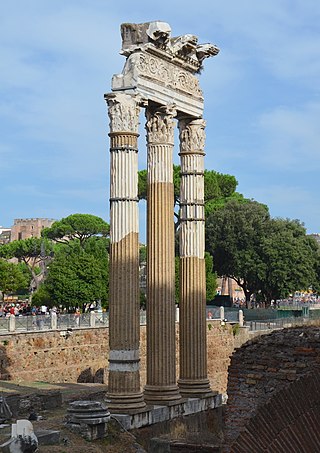
The Temple of Venus Genetrix is a ruined temple in the Forum of Caesar, Rome, dedicated to the Roman goddess Venus Genetrix, the founding goddess of the Julian gens. It was dedicated to the goddess on 26 September 46 BCE by Julius Caesar.
The Roman imperial cult identified emperors and some members of their families with the divinely sanctioned authority (auctoritas) of the Roman State. Its framework was based on Roman and Greek precedents, and was formulated during the early Principate of Augustus. It was rapidly established throughout the Empire and its provinces, with marked local variations in its reception and expression.

Caesar Augustus, known as Octavian before he became emperor, was the first and among the most important of the Roman Emperors. As such, he has frequently been depicted in literature and art since ancient times.
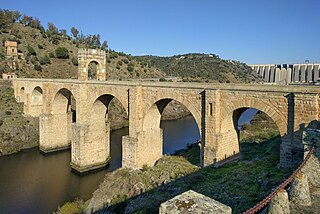
The Alcántara Bridge is a Roman bridge at Alcántara, in Extremadura, Spain. Alcántara is from the Arabic word al-Qantarah (القنطرة) meaning "the arch". The stone arch bridge was built over the Tagus River between 104 and 106 AD by an order of the Roman emperor Trajan in 98.
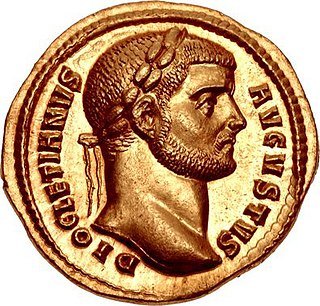
Augustus was the main title of the Roman emperors during Antiquity. It was given as both name and title to Gaius Julius Caesar Octavianus in 27 BC, marking his accession as Rome's first emperor. On his death, it became an official title of his successor, and was so used by all emperors thereafter. The feminine form Augusta was used for Roman empresses and other female members of the imperial family. The masculine and feminine forms originated in the time of the Roman Republic, in connection with things considered divine or sacred in traditional Roman religion. Their use as titles for major and minor Roman deities of the Empire associated the imperial system and family with traditional Roman virtues and the divine will and may be considered a feature of the Roman imperial cult.
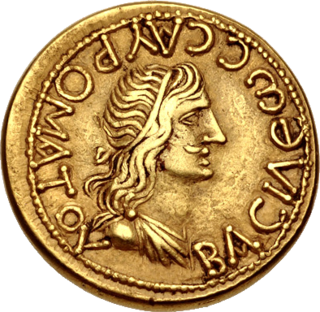
Sauromates I was a Roman client king of the Bosporan Kingdom.
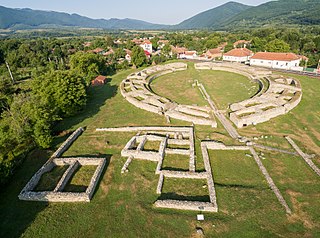
Ulpia Traiana Augusta Dacica Sarmizegetusa was the capital, the first, and largest city of Roman Dacia, named after Sarmizegetusa the former Dacian capital, located some 30 km away. It was founded in 106 as a colonia deducta and elavated to metropolis during the reign of Severus Alexander. The present village of Sarmizegetusa has been built over parts of it.
The Feriale Duranum is a calendar of religious observances for a Roman military garrison at Dura-Europos on the Euphrates, Roman Syria, under the reign of Severus Alexander.















